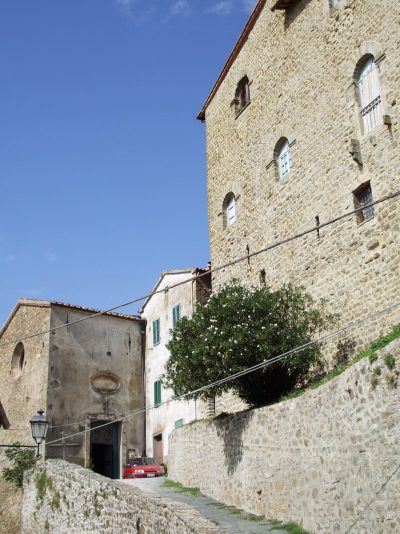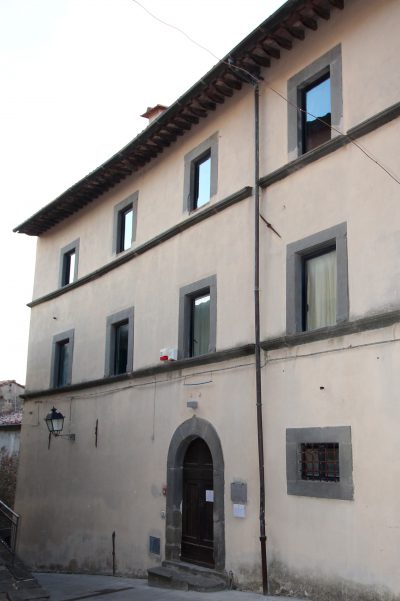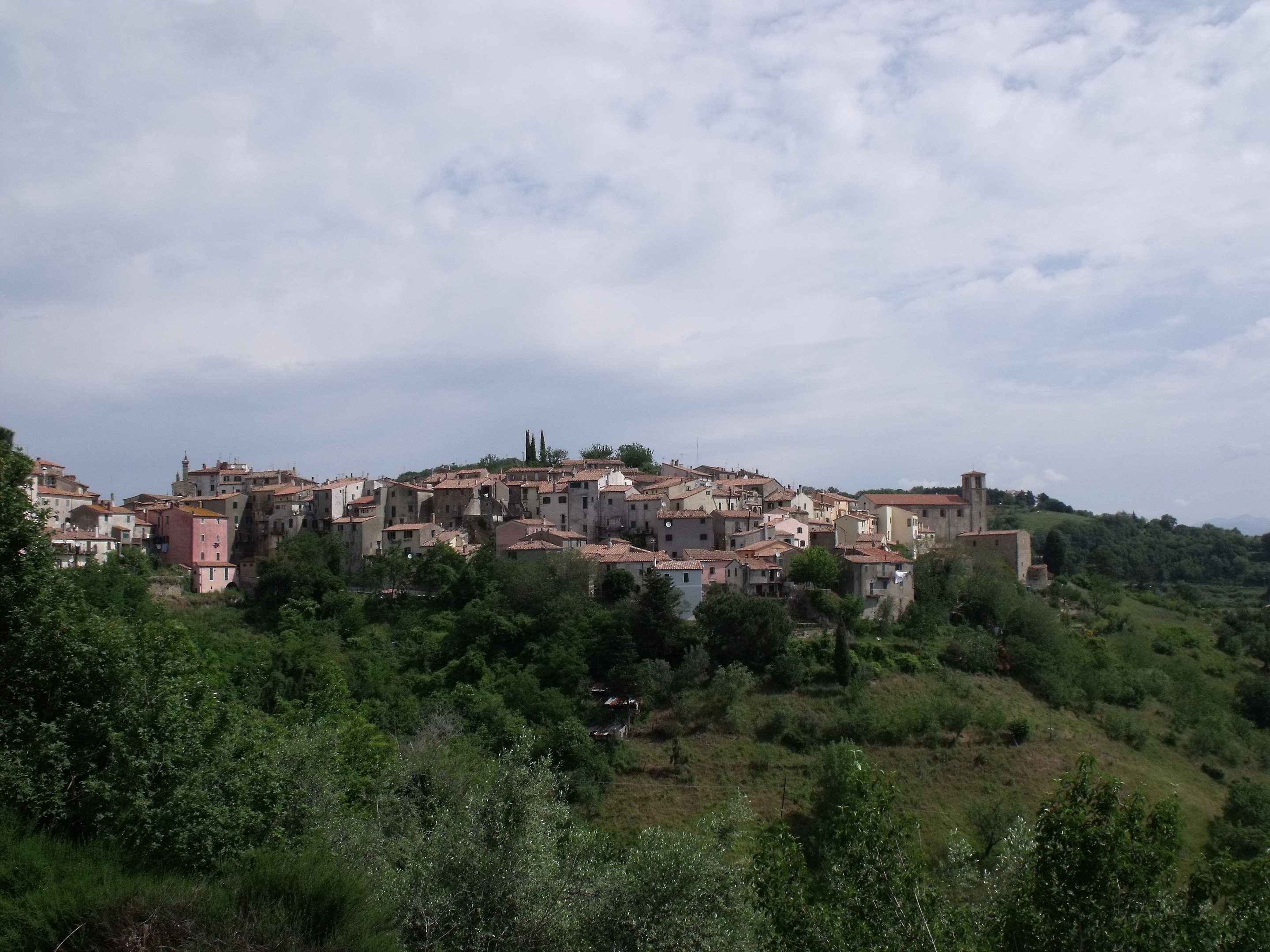Scansàno is a municipality known for having given the denomination to Morellino di Scansano, a DOCG red wine produced in the area.
The territory extends mainly to medium-low hilly altitudes, reaching the minimum altitudes near the torrential waterways.
In the area of Scansano Etruscan and Roman settlements are documented (Ghiaccio Forte, Aia Nova, Scrina di Porco), while the first news of the medieval center it dates back to 918, when a certain curtis Mustia is mentioned, identifiable with the hamlet of Murci. During the Middle Ages, many castles of great strategic importance arose in the Scansanese area, such as Montorgiali, Cotone and Montepò, while the castle of Scansano, certified in 1274, was disputed in the 14th century between the Aldobrandeschi counts and the Tolomei of Siena.
Places of Interest
•Church of San Giovanni Battista, mentioned since 1276, was radically restructured in the 18th century. On the gabled façade, the fifteenth-century portal with an oval frame stands out.
Inside, note the altars made in the 18th century in plaster and stucco, and some paintings: the Madonna offering the Bambino a Sant’Anna, from the beginning of the 17th century; the Martyrdom of San Sebastiano, attributed to Stefano Volpi; Our Lady of Help. An elegant fifteenth-century polychrome frame with festoons enclosed the Madonna dell’uccellino, glazed terracotta from the workshop of Andrea della Robbia, stolen in 1971 and replaced by a copy. The Madonna was found in 2019, but still not relocated to the church.
In the presbytery, polychromed wooden statue of the Madonna, from the 15th century. In the apse, a fine seventeenth-century wooden choir.
• Convento del Petreto (or convent of San Pietro), located outside the town before the crossroads for Manciano, has medieval origins – tradition says that Saint Bernardino preached here in 1422 – but it underwent various alterations over the following centuries. Above the entrance portal there is an eighteenth-century lunette with the Madonna and Child between Saint Francis and Saint Peter, while inside another lunette, placed above the altar, depicts God the Father in glory among musician angels.
The complex consists of the church of San Pietro and the adjoining convent, originally an Observant Franciscan, suppressed in 1871 and currently privately owned.
Inside, note the imposing high altar, built in the 17th century in plaster and stucco. In the apse there is a wooden choir in precarious conditions of conservation.
Inside was the Annunciation, dating back to 1615, which was later moved to the sacristy of the church of San Francesco in Grosseto.
•Palazzo Pretorio, dating back to the 15th century, was the civic building of the municipality of Scansano and still today maintains its original appearance with simple and squared shapes and the windows framed in pietra serena. In the 19th century it was also used as a prison.
•Palace of the old hospital, dating back to the 15th century, was the seat of the small hospital of Scansano. Today it looks like a private residence.
•Teatro Castagnoli, built between 1852 and 1891 – the works underwent various interruptions – is one of the main theatres in the province of Grosseto. From 1968 it was used as a cinema and ceased its activity in 1982. Acquired by the Municipality, the theater is now open again.

Partial view of the castle of Montorgiali and the church of San Biagio
•Walls of Scansano: the original nucleus was built by the Aldobrandeschi starting from the 12th century, then completed during the following century. Numerous redevelopment interventions were carried out in the 15th century, including the addition of a watchtower and the reconstruction of the gateway to the village (16th century). The fifteenth-century watchtower with a circular section on the eastern side and the characteristic Porta Grossetana on the western side remain visible.
•Castello di Montorgiali, built during the 12th century as a possession of the counts of Montorgiali, vassals of the Santa Fiora branch of the Aldobrandeschi family, if there is a first reference to it in a bull of Pope Clement III dating back to 1188. In the 18th century the castle ended up in private hands and during the last century it was divided into several housing units.
Between the building adjacent to the church and the left corner of the castle there is a stone curtain wall, where there is a round-arched door, above which is the coat of arms with the lion of the people of Siena ; another door with a segmental arch is located on the northern side.
The castle looks like an imposing rustic structure made up of a series of buildings leaning against each other; the external walls completely covered in stone filaretto. The windows, arranged on 3 levels, have a round arch, while in some points of the external walls, loopholes and shelves are visible which were used to attack any enemies who approached them.
•The castle of Montepò is a mighty and elegant fortified structure which rises in the countryside north of Scansano, about 30 km east of Grosseto.
The fortified structure was built around the year one thousand near an ancient parish church, but was almost entirely rebuilt in the fourteenth century when it was controlled by the lords of Cotone.
In the Renaissance period, the new owners transformed the castle structure into a fortified farm and, in later periods, some renovations were made which led to expansions. The latest restorations carried out in the second half of the last century have brought the complex back to its former glory.
The castle of Montepò presents itself as a rare example of a Sienese fortified villa of the Renaissance period, thanks to the transformation interventions carried out between the fifteenth and sixteenth centuries.
The complex, with a rectangular plan, is arranged with the buildings around an internal courtyard; it is flanked by four corner towers with a square section, which in the past performed watching functions. The wall structures are in stone, with some brick cladding on the facades that open onto the internal courtyard.
The castle, currently owned by the Biondi Santis, is an integral part of a renowned farm specialized in the production of excellent wines; previously, it had been the place of inspiration of the British writer Graham Greene.
Museums
The municipality of Scansano has two museums which together form a single museum complex inside the ancient Palazzo Pretorio. The complex is part of the provincial network Museums of Maremma: The archaeological museum and the Museum of Vines and Wine.
• The archaeological museum was inaugurated in March 2001 and its purpose is to offer an overview on the history of the human presence in the ancient age in the middle Albegna valley. The exhibits on display are mainly attributable to the archaeological areas most studied and excavated since 1999, such as the Etruscan settlement of Ghiaccio Forte and the Roman one in Aia Nova.
The site of Ghiaccio Forte was discovered for the first time in 1970 by the archaeological group led by Zelindo Biagiotti. The first important excavation campaign (1979-1981) brought to light many finds which were thus restored. In 1981, at the same time as the excavations at Ghiaccio Forte, a Roman villa was found which was reused in the 3rd century AD. in Civitella, while in 1985, in Scrina di Porco, some remains of an ancient farm re-emerged. Another onean important excavation campaign was carried out in the years between 1987 and 1990, by Mario Del Chiaro, in the locality of Aia Nova: this made it possible to bring to light a large Roman productive villa, interesting for the presence of a thermal plant and some decorations on the floors and walls. In 1999 the restoration and new archaeological campaigns resumed: first a medieval necropolis was discovered in the locality of Poderuccio in Poggioferro, after which, in the years between 1999 and 2002, new excavations were carried out at Ghiaccio Forte directed by Marco Firmati.
The museum exhibits all the finds found in these places. The most interesting pieces come from the votive deposit of the sanctuary of Ghiaccio Forte (7th century BC), before the construction of the fortified settlement: a collection of votive heads and above all statuette depicting a grape harvester holding a billhook in his right hand. The structure is constantly enriched with new contents on the most recent research, the itinerary offers an updated picture of archaeological studies with particular attention to the most recent ones, which describe an ancient economy strongly linked to the production and trade of wine.

Archaeological and Vine and Wine Museum
•The vine and wine museum was inaugurated in June 2000 and is divided into five areas: historical area (wine archaeology); area of production; area of the cycle of the vine and wine; area of traditions (laboratory of taste); information area.
The museum aims to document and explore the evolution of the wine tradition in Maremma, in particular reference to the Scansano area, known throughout Italy for the production of DOCG Morellino wine. The first section is linked to the archaeological museum illustrating the methods of cultivation and processing of grapes, with consequent production of wine, in antiquity since the times of the Etruscans. The old traditional objects are exhibited, such as the stick of the donkeys that carried the “bigonzi” of grapes from the vineyards to the cellars, and particular attention is also paid to the appearance aesthetic of the plots of vineyards that wind through the hills of Scansano. Finally, some wines from the lower Maremma are illustrated and shown: Morellino, Parrina, Ansonica, Bianco di Pitigliano, Capalbio and Sovana.
Inside the museum there is also a space for tasting wines and local products supplied by the companies of the “Strade del vino e dei Sapori Colli di Maremma” association.



